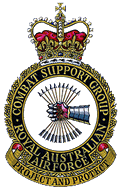
The Royal Australian Air Force (RAAF) is the principal aerial warfare force of Australia, a part of the Australian Defence Force (ADF) along with the Royal Australian Navy and the Australian Army. Constitutionally the Governor-General of Australia is the de jure Commander-in-Chief of the Australian Defence Force. The Royal Australian Air Force is commanded by the Chief of Air Force (CAF), who is subordinate to the Chief of the Defence Force (CDF). The CAF is also directly responsible to the Minister for Defence, with the Department of Defence administering the ADF and the Air Force.

The Australian Defence Force (ADF) is the military organisation responsible for the defence of the Commonwealth of Australia and its national interests. It has three branches: the Royal Australian Navy (RAN), Australian Army and the Royal Australian Air Force (RAAF). The ADF has a strength of just over 89,000 personnel and is supported by the Department of Defence alongside other civilian entities.
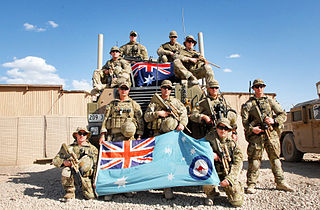
Airfield Defence Guards (ADG) are a mustering of the Royal Australian Air Force (RAAF) that are dedicated to the security and ground defence of airbases and other military aviation assets. Other duties include training other RAAF personnel, in skills such as the handling of small arms and infantry tactics. They do not, however, operate anti-aircraft artillery or missiles.
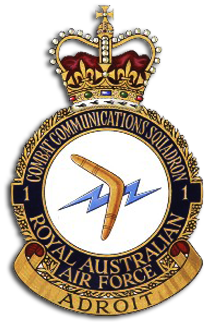
The Royal Australian Air Force's No. 1 Combat Communications Squadron (1CCS) is a squadron within No. 95 Wing and is responsible for the provision of expeditionary Communications and Information Systems (CIS) to support Air Force and Australian Defence Force operations and exercises.

RAAF Base Tindal is a Royal Australian Air Force (RAAF) military air base and civil aviation airfield located 8 nautical miles east southeast of the town of Katherine, Northern Territory in Australia. The base is currently home to No. 75 Squadron and a number of non-flying units, and also hosts the civilian Katherine Tindal Airport. First constructed in 1942, it was refurbished in the late 1960s as a bare base capable of being utilised when required. It was opened as a permanently manned RAAF base in 1989.
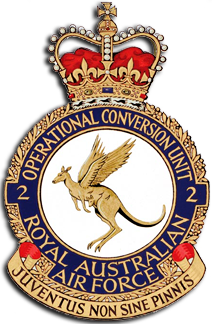
No. 2 Operational Conversion Unit is a fighter training unit of the Royal Australian Air Force (RAAF). Located at RAAF Base Williamtown, New South Wales, the unit trains pilots to operate the Lockheed Martin F-35 Lightning II. Pilots new to the F-35 enter No. 2 2OCU after first qualifying to fly fast jets at No. 79 Squadron and undertaking initial fighter combat instruction at No. 76 Squadron. Once qualified on the F-35, they are posted to one of No. 81 Wing's operational F-35 units, No. 3 Squadron, No. 75 Squadron or No. 77 Squadron.
The Royal Australian Air Force (RAAF) traces its history back to the Imperial Conference held in London in 1911, where it was decided aviation should be developed within the Armed Forces of the British Empire. Australia implemented this decision, the only country to do so, by approving the establishment of the Central Flying School (CFS) in 1912. The location for the proposed school was initially to be at Duntroon, Australian Capital Territory, but in July 1913 Point Cook, Victoria, was announced as the preferred location. The first flights by CFS aircraft took place there in March 1914.

No. 4 Squadron is a Royal Australian Air Force squadron composed of the air force special forces Combat Controllers, aircrew who operate the Pilatus PC-21 aircraft and instructors for the Australian Defence Force Joint Terminal Attack Controller (JTAC) course.
No. 292 Squadron is a Royal Australian Air Force (RAAF) operational conversion unit based at RAAF Base Edinburgh, South Australia. The squadron was formed on 1 January 1977 as the Maritime Analysis Training Squadron and renamed No. 292 Squadron on 27 October 1980. Throughout its history it has formed part of No. 92 Wing and been responsible for training aircrew to operate the RAAF's Lockheed P-3 Orion and Boeing P-8A Poseidon maritime patrol aircraft. It took responsibility for training Poseidon maintenance and operations personnel in 2018.

RAAF Base Wagga is a Royal Australian Air Force (RAAF) military air base located 11 kilometres (6.8 mi) south-east of Wagga Wagga, in the suburb of Forest Hill, New South Wales, Australia.
RAAF Base Woomera (WMA), was proclaimed by Chief of Air Force Directive in January 2015. RAAF Base Woomera and the RAAF Woomera Test Range (WTR) are the two formations which make up the RAAF Woomera Range Complex (WRC). RAAF Base Woomera consists of two sectors, 'Base Sector North' which is a restricted access area and includes Camp Rapier. the entrance to the Woomera Test Range and the RAAF Woomera Airfield. 'Base Sector South' is accessible by the public and essentially encompasses that part of RAAF Base Woomera long referred to as the Woomera Village. Woomera Village is often quoted as a 'remote town'. It is not a 'town', but rather an 'open base' of the RAAF. The 'village' has previously always functioned as an Australian Government/Defence Force garrison facility until it was fully incorporated into RAAF Base Woomera in 2015.
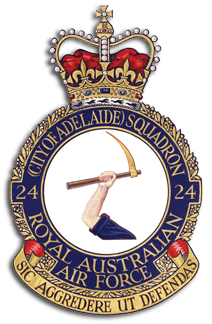
No. 24 Squadron is a Royal Australian Air Force squadron. The squadron was formed in 1940 and saw action as a bomber squadron during World War II serving in the Pacific theatre against the Japanese, and undertaking operations during the Battle of Rabaul, and the New Guinea, New Britain and Borneo campaigns. The squadron was disbanded in 1946 following the conclusion of hostilities, but was re-formed in 1951. From then until 2010 the squadron was an RAAF Reserve squadron located near Adelaide, South Australia; for part of this time, until 1960, the squadron continued to perform flying duties, before converting to a ground support role. In 2010, the squadron combined with Combat Support Unit Edinburgh to become a Permanent Air Force unit and it currently forms part of No. 96 Wing, Combat Support Group.

No. 86 Wing is a Royal Australian Air Force (RAAF) transport and air-to-air refuelling wing. Coming under the control of Air Mobility Group, it is headquartered at RAAF Base Amberley, Queensland. The wing comprises No. 33 Squadron, operating Airbus KC-30 tanker-transports, No. 36 Squadron, operating Boeing C-17 Globemaster III heavy transports, and the Australian Army's 68 Ground Liaison Section. Its aircraft support Australian military and humanitarian operations worldwide.

No. 84 Wing is a Royal Australian Air Force (RAAF) transport wing. Coming under the control of Air Mobility Group (AMG), it is headquartered at RAAF Base Richmond, New South Wales. The wing comprises No. 35 Squadron, operating Aliena C-27J Spartan transport Aircraft; No. 37 Squadron, operating Lockheed Martin C-130J Super Hercules medium transports; and a technical training unit, No. 285 Squadron.

The Royal Australian Air Force's Air Combat Group (ACG) is the group which administers the RAAF's fighter and bomber aircraft. ACG was formed on 7 February 2002 by merging the RAAF's Tactical Fighter Group and Strike Reconnaissance Group in an attempt to improve the speed with which the RAAF can deploy its combat aircraft.

No. 81 Wing is responsible for operating the Lockheed Martin F-35 Lightning II multi-role fighters of the Royal Australian Air Force (RAAF). Headquartered at RAAF Base Williamtown, New South Wales, the wing comprises three combat units, Nos. 3 and 77 Squadrons based at Williamtown and No. 75 Squadron at RAAF Base Tindal, Northern Territory, as well as an operational conversion unit at Williamtown. No. 81 Wing headquarters oversees squadron training in air-to-air and air-to-ground tactics, and support for the Australian Army and Royal Australian Navy. Tasked with offensive and defensive counter-air operations, the Hornets have been deployed to Diego Garcia in 2001–02, when they provided local air defence, to Iraq in 2003, when they saw action flying fighter escort and close air support missions in concert with Coalition forces, and to the Middle East in 2015–16, when they undertook strike operations during the military intervention against ISIL. They have also been employed to patrol high-profile events in Australia, including the Commonwealth Games and visits by foreign dignitaries.
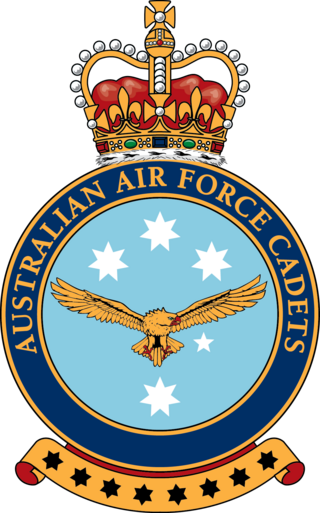
The Australian Air Force Cadets (AAFC), known as the Air Training Corps (AIRTC) until 2001, is a Federal Government funded youth organisation. The parent force of the AAFC is the Royal Australian Air Force (RAAF). Along with the Australian Army Cadets (AAC) and the Australian Navy Cadets (ANC), it is part of the Australian Defence Force Cadets.
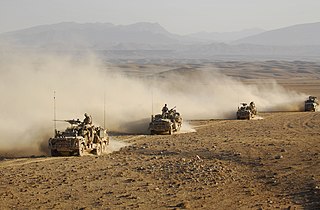
The special forces of the Australian Defence Force are units of Special Operations Command and associated units of the Royal Australian Navy and the Royal Australian Air Force that conduct and or support special operations to advance and protect the national security of the Commonwealth of Australia. The special forces of Australia have a lineage to a variety of units raised in the Second World War such as the Independent and Commando Companies, Z Special Unit, Navy Beach Commandos, and the Coastwatchers. Australian special forces have most recently been deployed to Iraq in Operation Okra as the Special Operations Task Group, as the Special Operations Task Group in Afghanistan, in Afghanistan in support of the Australian Secret Intelligence Service and regularly for counter-terrorism pre-deploy to locations of major domestic events throughout Australia in readiness to support law enforcement such as the 2014 G20 Brisbane summit.

The Lockheed AP-3C Orion is a variant of the P-3 Orion used by the Royal Australian Air Force (RAAF) for tasks such as naval fleet support, maritime surveillance, search and survivor supply and anti-surface and anti-submarine warfare. The 18 AP-3C Orions were upgraded from P-3Cs between 1997 and 2005, with the program taking three years longer than expected due to systems integration problems. All 18 AP-3C Orions are operated by No. 92 Wing which is based at RAAF Base Edinburgh in South Australia. Aircraft from the wing have seen service as part of Australian Defence Force operations in Australia, South East Asia and the Middle East.
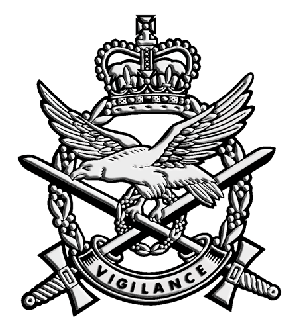
The Australian Army Aviation (AAAvn) is an administrative corps of the Australian Army. It was formed on 1 July 1968. The motto of the Australian Army Aviation corps is Vigilance.
